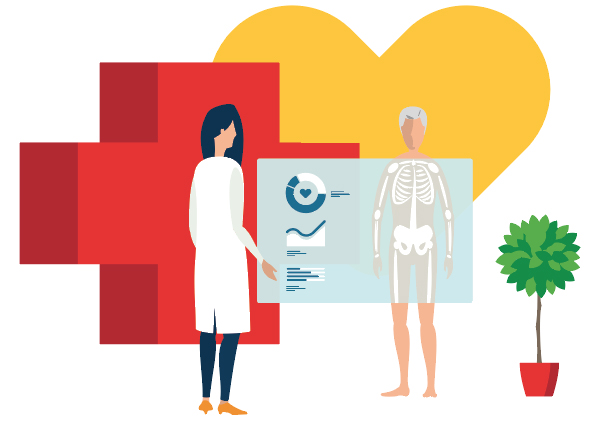About 90 percent of our bone mass is developed by age 20 and the rest by age 30, says Andrea Singer, clinical director at the National Osteoporosis Foundation (NOF) and director of bone densitometry at MedStar Georgetown University Hospital.
After that, a host of factors from genetics to gender to lifestyle choices determine how our bones will fare the rest of our lives. Though a gradual decline in bone health can be expected as we get older, the low bone density and fracture risk associated with osteoporosis are issues many can avoid.
“The risk certainly goes up as we get older, but that shouldn’t be something we accept,” Singer says. “And that’s why we want to motivate people to do all of the things they can to ensure that their bones are as strong as they can be.”
Osteoporosis actually means “porous bone,” referring to the the holes and spaces in our bones’ honeycomb structure that grow larger in people with the condition. It’s often called a silent epidemic, as there are generally no symptoms until there is a fracture.
Other early signs may include a decrease in height or curvature of the back or spine. More than 10 million U.S. adults over age 50 are living with osteoporosis, according to the NOF, and another 43 million have low bone mass. Women are at the greatest risk as a loss in bone-protecting estrogen can decrease bone mass up to 20 percent within 5 to 7 years after menopause.
KNOW YOUR RISK
Age itself is the No. 1 osteoporosis risk factor for both genders, Singer says, but some others include:
- PRIOR FRACTURES
Any previous fracture as an adult significantly increases the risk of future fractures. - FAMILY HISTORY
A hip fracture in mom or dad is particularly relevant. - SMALL FRAMES
People who have low body weight tend to have smaller, less dense bones. - MEDICATIONS
Certain medications, such as steroids, can contribute to bone loss. It’s important to talk to your doctor about the benefits and risks of medications. - OTHER CONDITIONS
Some other health conditions, such as diabetes, autoimmune disorders, digestive disorders, cancer, and others can impact bone health. - LIFESTYLE CHOICES
Smoking, excessive alcohol intake and a sedentary lifestyle can all increase the risk of developing osteoporosis.
GET TESTED
Singer says any woman over 65 should have a bone density test, the gold standard of which is a DXA (dual-energy x-ray absorptiometry) scan. The noninvasive test takes about 15 minutes and compares a patient’s bone density with that of a group of healthy, normal controls. The result is measured in a T-score—osteoporosis is diagnosed at a score of -2.5 or lower.
“Even people who have bone densities that are not in the osteoporotic range, such as those with low bone mass or osteopenia, can still have fractures,” Singer says. “That’s where looking at bone density in combination with risk factors is very important.”
If osteoporosis is diagnosed, a variety of medications, the most commonly prescribed class of which is bisphosphonates, might be recommended and an individual health plan should be created, Singer says. Testing aside, she says everyone should make bone health a topic of conversation with their doctor.
“If a health care provider is not asking about bone health, ask about it,” she says. “Make sure they are paying attention to your risk factors.


